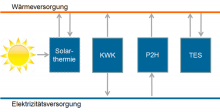
In the course of the energy transition and the associated expansion of renewable energies, new tasks are also imminent in the area of heat supply. In addition to the possibility of using electrical energy generated from regenerative energy sources for heating with the sector-coupled “power-to-heat” concept, solar thermal technology is a technology that uses solar radiation directly to generate heat.
In order to counteract the disadvantage of the dependent fluctuating supply, an interaction with other technologies is necessary for solar thermal energy. In combination with, for example, cogeneration or thermal energy storage, but also with power-to-heat, a technology mix can be created that enables an increased proportion of regenerative energy in the heat supply.
For the question of what contribution such concepts can actually make to climate protection, the decisive factor is whether such systems are built and how they are operated. It can be assumed that the economic efficiency from the point of view of potential operators will be the decisive criterion for both.
The SolWW-SH project examines under which circumstances which technical concepts for solar thermal-assisted heat supply are economically attractive for investors and operators and how this has a positive effect on the energy supply system.
For this purpose, different technical concepts are simulated in different scenarios in terms of an economically optimal system operation. The appraisal of the attractiveness of the concepts and their system effect is based on the determined operating data and the boundary conditions that are derived from the surrounding supply system and the plant itself. The identification of economically resilient concepts provides an orientation on how heat supply companies can make an additional contribution to climate protection in a future-proof and economically viable manner.
